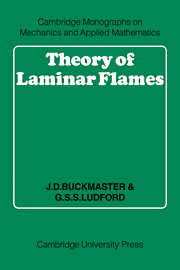Book contents
- Frontmatter
- Contents
- Preface
- 1 Governing equations of combustion
- 2 The premixed plane flame
- 3 Perturbations: SVFs and NEFs
- 4 Steady burning of a linear condensate
- 5 Unsteady burning of a linear condensate
- 6 Spherical diffusion flames
- 7 Cylindrical and spherical premixed flames
- 8 Multidimensional theory of premixed flames
- 9 Burners
- 10 Effects of shear and strain
- 11 Stability
- 12 Ignition and explosion
- Text references
- Further references
- Citation Index
- Subject Index
3 - Perturbations: SVFs and NEFs
Published online by Cambridge University Press: 05 May 2010
- Frontmatter
- Contents
- Preface
- 1 Governing equations of combustion
- 2 The premixed plane flame
- 3 Perturbations: SVFs and NEFs
- 4 Steady burning of a linear condensate
- 5 Unsteady burning of a linear condensate
- 6 Spherical diffusion flames
- 7 Cylindrical and spherical premixed flames
- 8 Multidimensional theory of premixed flames
- 9 Burners
- 10 Effects of shear and strain
- 11 Stability
- 12 Ignition and explosion
- Text references
- Further references
- Citation Index
- Subject Index
Summary
Prologue
The propagation speed of a plane deflagration wave is extraordinarily sensitive to changes in the flame temperature. The result (2.22) shows that, for fixed D and Js, an O(1) change in Tb produces an exponentially large change in the burning rate. More modestly, an O(θ–1) change in Tb produces an O(1) change in flame speed; it is perturbations of such a magnitude that concern us in this chapter.
Such a change may be engineered for the unbounded flame by an O(θ−1) change in Tf, an elementary example that is not of great importance either mathematically or physically. A much more interesting example is cooling by heat loss through the walls of a uniform duct along which the flame is traveling. It is well known that flames cannot propagate through very narrow passages (a key safety principle where explosive atmospheres are involved), and this can be adequately explained by such a heat-loss mechanism, as we shall see.
Perturbations of the same magnitude can also be produced by changes in the size of the duct that occur over distances O(θ). Now there will be slow variations in the combustion field developing on a time scale O(θ). Such slow variations can even be self-induced by residual perturbations of the initial conditions (on that time scale) in the absence of boundary perturbations. In all such cases an obvious conjecture is that the flame velocity is not close to the unperturbed value.
- Type
- Chapter
- Information
- Theory of Laminar Flames , pp. 38 - 57Publisher: Cambridge University PressPrint publication year: 1982
- 3
- Cited by



